The Palm Species Navigator

February 2025 - Welcome!

Sabal Palm Facts - Take the Challenge!
Develop some subtle wisdom to get the knack of Identifying Tricky Palms!
Ever walked past two nearly identical palms and thought, "Are they twins, or just really good friends?" ☺️ Maybe they're plant "cousins" within the same Genera - like those we'll show you.
Or maybe you've ambled through a palmy area, whether on a tropical vacation, in a park, or at The Botanical Garden. And your mind swirled at seeing all those palms, that sorta look the same - but then they don't!
Figuring out the small differences between similar-looking species can feel like cracking a secret code. But you don't need a botany degree to become a palm detective. It's a matter of looking at variations of small details.
Our species challenge helps you begin to sharpen your observation skills, with a little guidance. We'll practice with telling a Dominican Palm from a Puerto Rican Hat Palm.
"Focus on this moment. Hold your hand and see what it feels like. Go look at some grass. Talk to a palm tree…. Experience life."
- Frederick Lenz
Let's tackle this:
- Sabal domingensis vs.Sabal causiarum
- Seeing how they're quite similar
- Simple tips for spotting key differences
Our Palm Pair Challenge for Building ID Confidence
To figure out the ID of similar palms, it takes - yes - detail work. Those key fine points that will help get to the bottom of it!
Let's start practicing with this pair: Sabal domingensis (Dominican Palm) comparison to Sabal causiarum (Puerto Rican Hat Palm).
THE SIMILARITIES:
Both are Palmate, with large, round, fan-shaped leaves. And are deeply costapalmate, meaning the petiole (stem) goes way into the blade. Segment spaces go halfway to the stem.
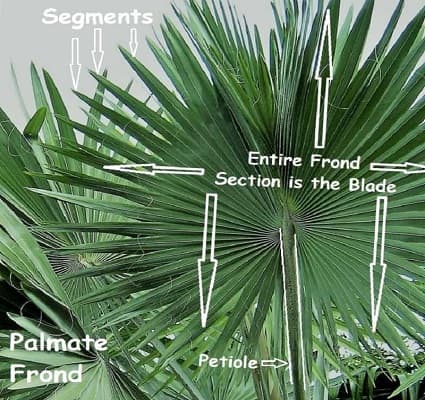 The Blade = leaf/segment area
The Blade = leaf/segment area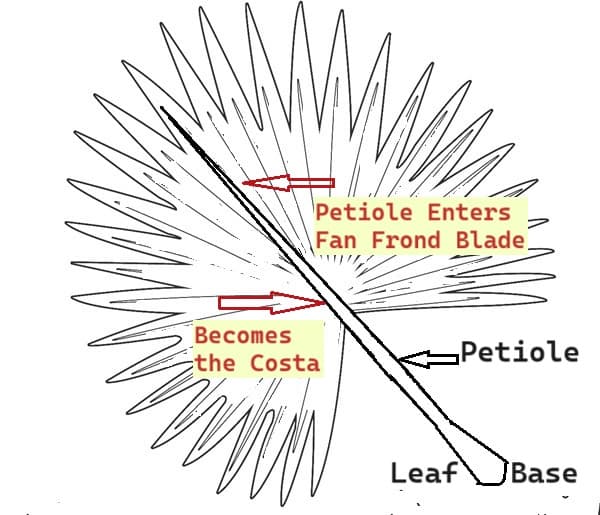 Demonstrating deeply costapalmate
Demonstrating deeply costapalmate- Both get approximately the same height, give or take, to 40-50ft/12-15m high.
- Both have 10ft/3m long branching flower stalks (inflorescences) continuing beyond the crown. With small whitish flowers that produce black fruit.
- Both have smooth trunks, light gray color.
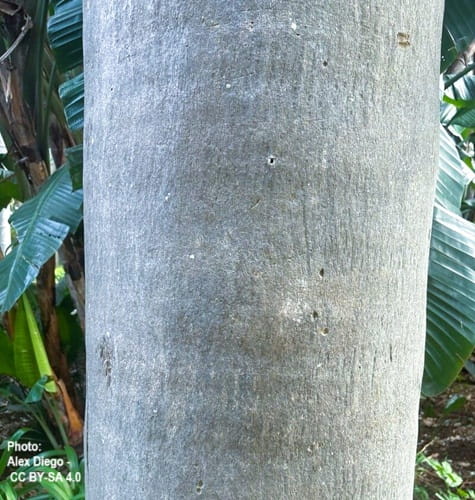 This is a Sabal causiarum trunk, the Sabal domingensis looks the same.
This is a Sabal causiarum trunk, the Sabal domingensis looks the same.- Both have regional nicknames with "Hat Palm" incorporated: the Dominican Hat Palm & the Panama Hat Palm - because locals use the fronds to make hats.
- Both are suitable for USDA Zones 8-11, but can't tolerate any temps below 10F/-12.2C.
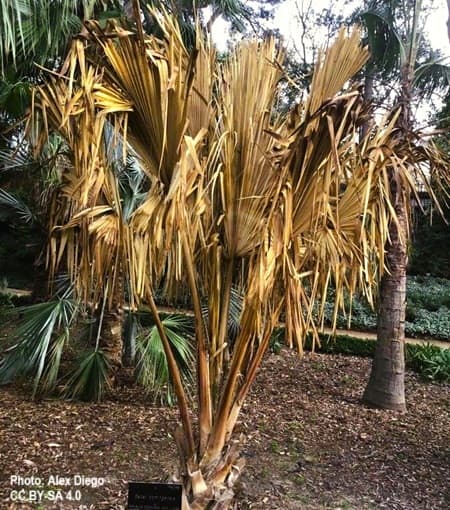 Ouch! - Sabal domingensis severely damaged by a freeze!
Ouch! - Sabal domingensis severely damaged by a freeze!Sabal causiarum is slightly more freeze-tolerant.
Let's see the tiny distinctions that do make a difference for identification.
Dominican Palm: S. domingensis
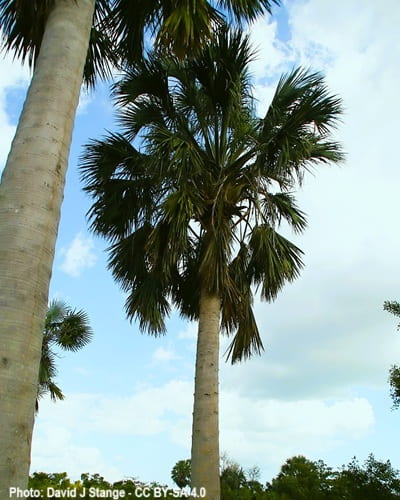
DISCERN A DOMINICAN PALM
Fronds - Mostly larger, deep-green, sometime bluish hue. Varied stiff segments tilt differently away from the costa, for a fuller crown appearance. Also making white intersegment threads easier seen.
Fruit - Round, 1/2in/1.27cm diameter.
Puerto Rican Hat Palm: S. causiarum
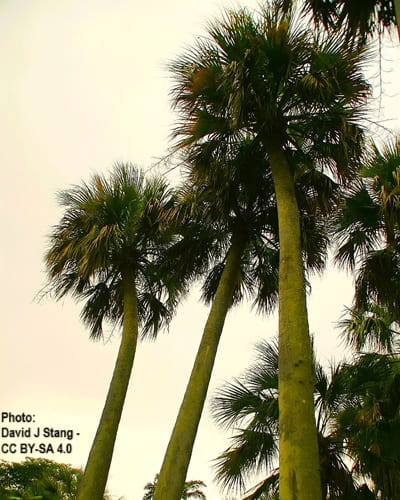
DISCERN A PUERTO RICAN HAT PALM
Fronds - Not quite as large, even deeper/ darker green color. Segments attached in a uniform plane & don't tilt differently. They're droopy. White threads amid segments aren't easily seen.
Fruit - A little bigger than 1/2in/1.27cm & pear-shaped.
Let's Throw Another Palm in the Mix
Since it looks quite similar to the Puerto Rican Hat palm & appears a little less similar to the Dominican Palm.
People have been known to confuse it with Sables because of its dense, full crown. It's the Bismarck Palm (Bismarckia nobilis).
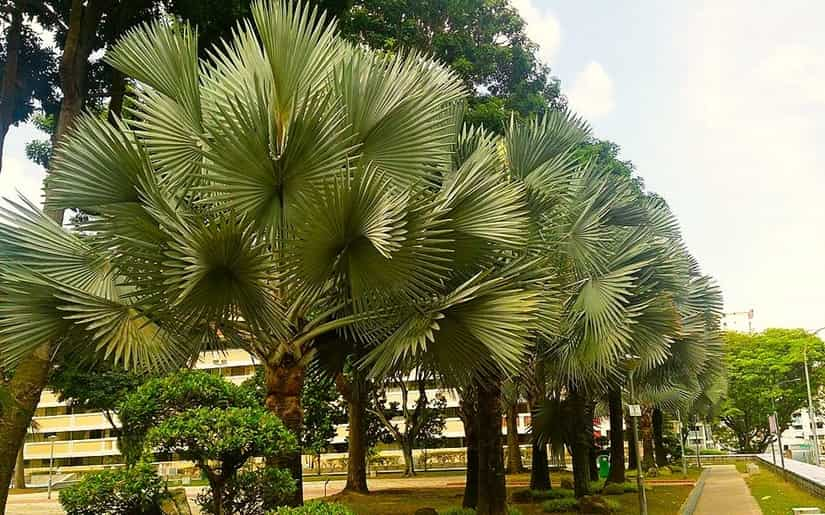 Streetside lineup of gorgeous Bismarck Palms
Streetside lineup of gorgeous Bismarck PalmsWhat's the same?
- Full round crown of palmate fronds.
- About the same total height.
- Wide, thick trunk.
What's different?
- Key differentiation: frond segment spaces go one-third of the way into the leaf blade, instead of halfway.
- Darkened trunk: dark gray or dark tan. With faint rings or slight depressions. Rougher texture.
- Flowers are purplish black on a shorter inflorescence.
- Producing Palm Fruit that's brown & larger, at 1.5in/4cm.
We Have Some Useful Resources
These are resources we like to use at times. That's why we recommend them. Check out the ones that could help you:
- Palmpedia is an excellent resource:
- We often Consult Palmpedia. Most listed palms are comprehensively described in this online encyclopedia.
- It uses lots of technical botanical vocabulary. But it's a great photo resource. With a handy search bar. As a wiki, we feel it's reliable, as authentic researchers are behind it.
- Here's an extraordinary network which unites plant conservationists, botanical gardens, arboreta, and other organizations working to save threatened plants.
Thinking About What You Learned on This Challenge
- Strategic similarities between Sabal domingensis and Sabal causiarum.
- Strategic differences between Sabal domingensis and Sabal causiarum.
- Strategic use of leaf shape, segments & their stiffness. Plus fruits to distinguish these similar palm species.
- Strategically separating out a similar looking species in a different Genus.
PRACTICING WITH EVALUATION & VARIENCE DETAILS
Put your knowledge to the test!
- Visit a local park, botanical garden, or even your neighborhood, and try to sort out these palm look-alikes. Bring your Palm Guide-Book for added help.
- Then take a photo of the palm you believe you've identified. Keep in mind those particular traits that will be helpful. Take close-ups, too.
- Share Your Photo with the best online community for feedback, PalmTalk. Since learning is more fun when shared!
We hope you enjoyed this palm species comparison.
To show you how digging deeply into close-up traits can help distinguish between palms. When some of them look so very much the same!
Watch for us again. Take care everyone.
Til Next Time,
Karen & Bill of Mission: Palm Trees

P.S. Don't miss Our Latest Articles - See what else we have for you, organized by subject, at our Mission: Palm Trees Site Index
P.P.S. Missed any Life Amid the Palms memos? Easily Check our past issues, by subject & date, of Life Amid the Palms Here>

